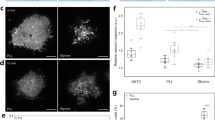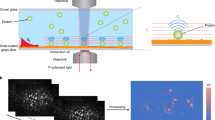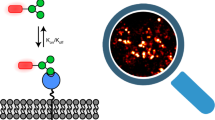Abstract
THE distribution of antigens and carbohydrate residues on the surfaces of cells, notably erythrocytes and lymphocytes, can be determined by binding antibodies or lectins to such macromolecules as ferritin1,2, haemocyanin3,4 or peroxidase2,5, which serve as markers for transmission electron microscopy. Improved techniques in high resolution scanning electron microscopy (SEM), however, make it possible to determine the topographical distribution of molecular receptors on the surfaces of cells and tissues by similar histochemical techniques involving markers resolvable by SEM. LoBuglio et al.6 used commercial polystyrene latex particles, 2,300Å in diameter, as immunological markers for SEM work. But applications of this reagent are limited because the hydrophobic surface of the particles makes them stick non-specifically to many surfaces and molecules.
This is a preview of subscription content, access via your institution
Access options
Subscribe to this journal
Receive 51 print issues and online access
$199.00 per year
only $3.90 per issue
Buy this article
- Purchase on Springer Link
- Instant access to full article PDF
Prices may be subject to local taxes which are calculated during checkout
Similar content being viewed by others
References
Nicolson, G. L., Masouredis, S. P., and Singer, S. J., Proc. natn. Acad. Sci. U.S.A., 68, 1416 (1971).
Wagner, M., Res. Immunochem. Immunobiol., 3, 185 (1973).
Smith, S. B., and Revel, J.-P., Devl. Biol., 27, 434 (1972).
Karnovsky, M., and Unanue, E. R., Fedn. Proc., 32, 55 (1973).
Avrameas, S., Int. Rev. Cytol., 27, 349 (1970).
LoBuglio, A. F., Rinehart, J. J., and Balcerzak, S. P., in Scanning Electron Microscopy, Part II, 313 (ITT Research Institute, Chicago, 1972).
Wichterle, O., in Encylopedia Polymer Sci. Tech., 15, 27B (Interscience, New York, 1971).
Cuatrecasas, P., J. biol. Chem., 245, 3059 (1970).
Hoffman, A. S., Schmer, G., Harris, C., and Kraft, W. G., Trans. Am. Soc. artif. int. Organs, 18, 10 (1972).
Goodfriend, T. L., Levine, L., and Fasman, G., Science, 144, 1355 (1964).
Bessis, M., and Weed, R. I., in Scanning Electron Microscopy, Part II, 289 (ITT Research Institute, Chicago, 1972).
Author information
Authors and Affiliations
Rights and permissions
About this article
Cite this article
MOLDAY, R., DREYER, W., REMBAUM, A. et al. Latex spheres as markers for studies of cell surface receptors by scanning electron microscopy. Nature 249, 81–83 (1974). https://doi.org/10.1038/249081a0
Received:
Issue Date:
DOI: https://doi.org/10.1038/249081a0
This article is cited by
-
Formation of monodisperse poly(1-methacryloxybenzotriazole) particles by radiation-induced dispersion polymerization
Colloid & Polymer Science (1989)
-
New functional microspheres with active succinimide groups
Colloid & Polymer Science (1987)
-
A review of cell surface markers and labelling techniques for scanning electron microscopy
The Histochemical Journal (1980)
Comments
By submitting a comment you agree to abide by our Terms and Community Guidelines. If you find something abusive or that does not comply with our terms or guidelines please flag it as inappropriate.



